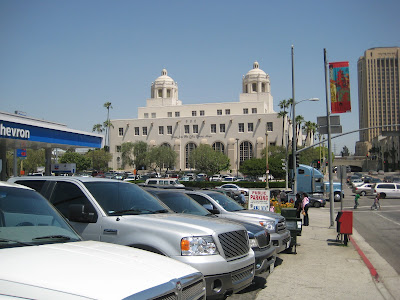This neighborhood on the banks of the L.A. River was founded in 1781 – on orders from the Spanish king – by a group of families from the San Gabriel Mission. The settlers consisted of 11 men, 11 women, and 22 children of Spanish, African and “mulatto” descent. They called their new home “El Pueblo de Nuestra Señora Reina de los Ángeles sobre El Rio Porciuncula” (“The Town of Our Lady Queen of the Angels over the Porciuncula River”). Initially, the town was clustered around the Old Plaza Catholic Church, which still stands on the west side of North Main Street. Later, the focus shifted to nearby Olvera Street, the heart of the Mexican community and site of this weekend’s Cinco de Mayo festivities.
The main tourist attraction in the neighborhood is the Avila Adobe, the oldest residence in Los Angeles – built in 1818 (nearly a decade before Mexico won its independence from Spain) by Mexican cattle rancher Don Francisco Avila. Avila’s descendants lived in the house until 1868 – with the exception of a short period of time during the Mexican-American War, when it was used as a U.S. military headquarters. The house passed through a number of hands in the following decades, and was eventually abandoned and condemned in the late 1920s. It was slowly brought back to life in the following decade, when it became a center of activity for the Mexican community.
Today, it’s hard to imagine the area surrounding the Avila Adobe (downtown Los Angeles) as open grazing land. A few weeks ago, we visited Rancho Los Cerritos in Long Beach, and I had a hard enough time imagining that area without all the roads and houses. The docent told us that Los Cerritos was a full day’s ride (by horse) from El Pueblo de Los Angeles, and that there was very little in between the two ranches. This is hard to fathom in a city of 4 million people. Still, there’s something magical about standing in the courtyards outside these two old houses – the walls are just high enough that you find your mind drifting into the past.
Not far from the Avila Adobe are several other historic landmarks: the Pelanconi House (the oldest brick house in Los Angeles, built in 1850), Pico House (the first luxury hotel in Los Angeles, finished in 1870), and the first Los Angeles fire station (built in 1884). On the other side of Alameda Street are the Post Office Terminal Annex, where author Charles Bukowski worked for many years, and Union Station, known to movie geeks like me as the futuristic police station in Ridley Scott’s movie “Blade Runner.”
 El Pueblo de Los Angeles - 1869 (photo from of the Los Angeles Public Library)
El Pueblo de Los Angeles - 1869 (photo from of the Los Angeles Public Library) Old Plaza Catholic Church
Old Plaza Catholic Church Olvera Street
Olvera Street Avila Adobe
Avila Adobe Los Cerritos
Los Cerritos Pelanconi House
Pelanconi House Pico House
Pico House Fire House #1
Fire House #1 Bukowski’s Post Office
Bukowski’s Post Office Union Station
Union Station filming area inside Union Station
filming area inside Union Station
No comments:
Post a Comment